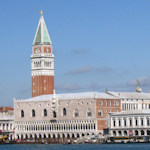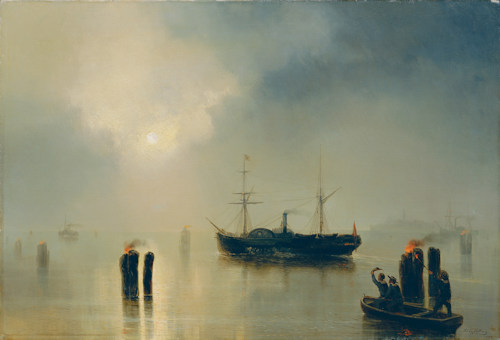
Ah, sweet Venice. City of myth, legend, and awestruck tourists. But how did we get here? When did Venice cast its spell on our perceptions?
For Austria, it was largely the 1800s, thanks to the influence of artists and writers. Lower Belvedere’s Viva Venezia! exhibition has the story.
- Explores the Austrian perceptions of Venice established in 19th-century art
- Features around 80 paintings
- Includes works by Makart, Jakob Alt, Passini, Romako, and many more
- Runs Feb 17 – Sept 4, 2022
- See also:
- Current art exhibitions
A 19th-century invention?

(Josef Carl Berthold Püttner, Night-sailing in the lagoon, 1857; press photo © Belvedere, Vienna)
Venezia, Venedig, Venice. La Serenissima. Queen of the Adriatic.
And not to be confused with Vienna: one British friend applauded my decision to emigrate here on account of all those lovely canals and Italian ice cream vendors. Austria’s capital has one canal. And it’s not even a canal.
Anyway, few locations live up to their reputation, but Venice is perhaps one of them.
And merely mentioning the name instantly conjures up images, even in those who have never found their way onto St. Mark’s Square or slipped a few coins to a Gondolier.
But where do those images come from?
Austria’s collective perception of Venice primarily began back in the 1800s, heavily influenced by pictorial representations of the city.
The Viva Venezia! exhibition explores the formative process that led to the creation in the 19th century of what we might call the myth or dream of Venice: a vision of the city driven by art and literature as much as true experience.
Curator Franz Smola has split the exhibition into three themes.
One section presents paintings of Venice through the ages, as imagined by artists like the hugely-influential Hans Makart (1840 – 1884).
Makart’s monumental Venice pays tribute to Caterina Cornaro, for example, depicts the court of the lady of Asolo around the turn of the 15th and 16th centuries. It feels like a scene from a fairytale or a location in Game of Thrones.
Another section commemorates the relationship between Austria and Venice (the Habsburgs once ruled the latter). Various Austrian artists travelled to the lagoon city, bringing inspiration and Venetian influences back to Vienna.
We even have excursions into history. One small room, for example, highlights the visit(s) of Emperor Franz Joseph and the inimitable Empress Elisabeth to Venice in the mid 1800s.
A third section looks more closely at the perceptions of Venice that were built in the 1800s and persist today. Venice as a place of magic and melancholy, longing and allure. And beauty (as many paintings demonstrate).
A striking aspect of many paintings of the city or its surrounds is the distinctive portrayal of light, as Illustrated, for example, in August Schöfft’s mid-19th century paintings of Palazzo Grassi and the Grand Canal.
It seems Disraeli was not wrong when he remarked around 1826:
Venice by moonlight is an enchanted city
Dates, tickets & tips
Admire Venice on canvas between February 17th and September 4th, 2022. Viva Venezia! takes place in the newly-refurbished Lower Belvedere galleries, so simply needs an entrance ticket for that part of the Belvedere palace complex.
Once inside, do drop into the neighbouring orangery, which hosts an exhibition (until May 29th) exploring the work of Salvador Dalí in the context of his inspirations, primarily Sigmund Freud.
And from June 15th, Lower Belvedere offers more in the way of 19th-century landscapes with a solo exhibition for the Vienna-born painter, Joseph Rebell (1787 – 1828).
How to get to Venice
Metaphorically speaking, of course. Simply follow the directions to reach Lower Belvedere and the exhibitions inside.
Address: Rennweg 6, 1030 Vienna